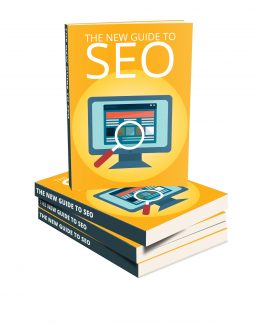 License Type: Master Resell Rights
License Type: Master Resell Rights  File Type: ZIP
File Type: ZIP
 SKU: 59904
SKU: 59904  Shipping: Online Download
Shipping: Online Download
Ebook Sample Content Preview:
Chapter 1: An Introduction to SEO – Still Kicking
If you want to get the maximum amount of profit from a website, then you need to get as much traffic as you can. If you want to get the maximum amount of traffic to your website, then you need to get to the top of Google.
And if you want to get to the top of Google, then you need SEO or ‘Search Engine Optimization’. Search Engine Optimization is the process of optimizing a website so that Google will be more likely to index it and ensure that it ranks highly for the most relevant key words and phrases. For example, if you have a website the sells hats, then you might try to get it to rank for the phrase ‘buy hats online’. To do this, you would go through an optimization process that would involve both ‘on site’ and ‘off site’ strategies.
With any luck, you would eventually be able to get your website to the top of the SERP for that term (‘Search Engine Results Page’) and thereby attract a huge amount of traffic. More importantly, that traffic would not just be from random visitors but would rather be from specific people who are looking for hats. Better yet, those people will be looking for hats at the very point that they came to your website (why else would they search for hats?) which thereby means that they’re ready to buy and it should only take a small push to get them to make that decision.
SEO can be a slow going process but it is still possible to very reliably climb the ranks and to get your website to a point where it will start getting more and more organic traffic from searches.
How SEO Works
SEO essentially works by attempting to second guess the algorithms used by Google to decide which sites to index and where to rank them. Google works by using bots, an index and an algorithm. The bots,
also known as ‘robots’ or ‘spiders’, are small pieces of code designed to head out onto the web and look for content. They read webpages and they add that content to a massive index, that Google can use as a reference.
From there, Google will then use an algorithm to identify which content in that index is relevant to which search – and which is offering value to the end user. Ultimately, the aim of Google is to help people find interesting content that will be relevant to what they’re looking for.
This involves a lot of factors and the algorithm will look at how many links the content has, how visitors behave on that website and the use of key phrases within the content. If a word or phrase is repeated often enough, then it is possible to deduce that said word or phrase is likely to be the subject matter – and thus it should come up in searches for matching terms.
SEO basically works by predicting and guessing how the algorithm works (because no one can be completely sure) and then using that information in order to engineer your website to get the maximum number of hits. It means gaming the system and this in turn can allow you to ‘trick’ Google into believing that your site should be number one.
Of course it’s not quite that simple though and actually, as we dig deeper, we’ll see that there are other ways of looking at SEO that are more efficient. Apart from anything else, Google is constantly updating its algorithms (usually with words beginning with ‘P’ like Penguin, Panda and Pigeon) and that means that second guessing Google can get you into trouble.
Being effective at SEO means having an up-to-date understanding of how it works and it means knowing the core principles that underlie the different strategies. That’s where this book comes in. Read on and you’ll learn which old, outdated strategies you need to avoid, how to work with Google to get the very best results and how to future-proof your site for upcoming changes.
This is the modern guide to SEO for modern marketers and site owners. This is your SEO bible and your key to unlocking incredible success on the web!
Chapter 2: SEO – What it Used to Mean
We’re going to start this book with a little history lesson.
Why? Because understanding how SEO used to work, how it has progressed and what you now need to avoid is a very good way of creating context and helping you to understand what SEO means today.
When SEO was first born, Google’s algorithm was a lot simpler and manipulating it to your own ends was a lot easier as a result. Back then, Google looked at two key factors in determining its rankings. Those factors were:
Keyword density Links profile
Your links profile (also called ‘backlinks profile’) is essentially determined by how many links you have pointing at your website, coming from other sites. This serves two important roles. Firstly, links help Google’s robots to find your website. Bots ‘crawl’ the web by reading content and following links from one site to another. If you have a link on a site that Google has already indexed, then this will allow it to find yours and add it to the network.
At the same time, Google views links as testimony – assuming that a website would only link to another website if it though that said website was good and had something valuable to offer its users. Google would also assume that if you have links from 20 websites about hats, then your site is probably going to be about hats as well (especially if the anchor text has your search phrase in it).
The other factor was keyword density. Keyword density meant how many times your website would repeat the words that you were trying to rank for. The more content you had and the more often you repeated the same phrase throughout that content, the more likely you would ultimately be to get ranked for that search term and to show up high in the SERPs.
Of course it was also important to research the keywords and to make sure that they were actually being searched for. For this, marketers could use Google’s keyword research tool in order to check the volume of searches and to get an idea of how much competition was there. A savvy optimizer would be able to then look at the terms that had the highest search volumes and lowest amount of competition – and then try to rank for those phrases specifically.
Enter Black-Hat SEO
This simple algorithm makes a lot of sense in theory and should have helped Google to find content that people would be looking for quickly and easily. It would read the content in order to see which site was most relevant for that term and it would look at which sites had the most links from other websites!
But the problem was that people eventually cottoned on to the way this worked and began to take advantage of it. SEOs realized that all they had to do to get to the top of Google was to create as many links and as much content (with keywords) as possible.
Thus, webmasters began to spam link directories and content farms – submitting their links everywhere they possibly could. They began to pay other content creators to place their links on their pages and they would also ‘trade’ links. Most websites ended up with a massive list of ‘links’ somewhere on one of their pages, which would just be other random sites that had contacted them and asked to exchange links.
Worst was what started to happen to the content. In a bid to create as much content as possible and to use the keywords as often as possible, creators began to churn out content in huge quantities while giving no regard to quality. They also began using ‘keyword stuffing’, which essentially means repeating keywords over and over again, even when it doesn’t make any sense.
A typical website from the early 2000’s might read:
“Are you looking to buy hats online? Then you have come to the right buy hats online website! This is the best place to buy hats online for anyone who wants to buy hats online Carolina.”
As you can see, this content gets completely nonsensical and would be highly off-putting for any real visitors looking to make a purchase!
And then it got worse still. Creators began to actively steel content from other site owners and then ‘spin’ it in order to make it unique (Google won’t rank duplicate content, otherwise it would risk making every search result identical!). Content spinning essentially means that you are taking an article or a blog post and then using software in order to exchange many of the words for synonyms.
Thus a sentence that read:
“These are the softest, warmest and most attractive hats on the net!”
Should become:
“These are the most comfortable, most insulating and most beautiful hats on the web!”
And because the site owner didn’t have to write that content themselves, this means that they can publish thousands of posts in a short space of time and ‘bomb’ Google.
That’s the theory at least. The reality is unfortunately that most spinners do this instead:
“These is the squishiest, hottest and very best beautiful hats on the fishing net!”
Again, it’s just gibberish.
So by placing thousands of links on other sites using their keywords as the anchor text and by filling their site with tons of useless content, website owners were able to get themselves to the top spot of Google. This system was so easy to abuse, that some people could even get completely unrelated websites to the top of specific SERPs against the owner’s will. You could make it so that searching for ‘big idiot’ would bring up a picture of your friend for example. This was called a ‘Google Bomb’.
Obviously this started to make a mess of Google’s results and so Google had to adapt and get smarter…
- License: Master Resell Rights
- Category:Ebooks
- Tags:2017 Ebooks Master Resale Rights








